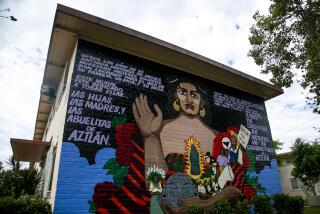Photographs Put Faces on O.C.’s Mexican Heritage
- Share via
Even in their heyday, their names -- Little Hollywood, La Fabrica, La Joya -- were on few maps.
The neighborhoods were among dozens of barrios that dotted Orange County, home to the region’s orange pickers and service workers. The residents were Mexicans and Mexican Americans who were, for the most part, prohibited by restrictive land covenants from buying property elsewhere in the first half of the 20th century.
Yolanda Morelos Alvarez and other local history buffs want to make sure they are not forgotten.
Morelos Alvarez, a part-time graphic designer at Chapman University in Orange, studied the barrios of Orange County and created a photo exhibit that has toured many venues in the last four years, including the Old Courthouse in Santa Ana and the Mission Viejo Library.
Now she has gone a step further, creating the Orange County Mexican American Historical Foundation, which she hopes will expand the photo collection and take it to local schools. She also hopes the group will be able to spread the word about the contributions of Mexicans and Mexican Americans in Southern California society, as well as the history of segregation.
It’s a message that Morelos Alvarez never received as a child growing up in Santa Ana.
“Our mothers didn’t talk about” segregation, she said. She remembers going with her mother into a Santa Ana department store and being ignored by the clerks. “It was like we were invisible.”
The photo exhibit, explains Joann Ramirez, a member of the foundation, “gives viewers a glimpse of history that they might not ever see.”
The photos -- contributions from families that Morelos Alvarez met in her research -- can be mundane. There are weddings and quinceanera portraits, pictures of families at Orange County beaches and on the barrio baseball fields. But some are telling. A few black-and-white shots show the tired faces of men in the fields, taking a break from the stoop labor that brought money into their simple homes.
Pictured elsewhere is the Mendez family, who initiated a lawsuit -- Mendez vs. Westminster School District in 1946 -- that desegregated Orange County schools and became the precedent for the more well-known Brown vs. Board of Education Supreme Court decision of 1954.
Says foundation member Al Garcia: “Many people don’t realize there’s a history behind Brown [vs. Board of Education] and that it began here.”
The stories of families such as these have been largely overlooked by local historical societies, Morelos Alvarez said. In fact, some historical societies have contacted her, hoping to use the photos in their exhibits, she said.
Local agencies “often are unaware of this history, a hidden thing to many people. So they just have not pursued it until now,” she said.
The foundation operates out of Morelos Alvarez’s home in Orange, where she has a room nearly filled with photos. The group already has 44 members who paid a $15 membership fee.
They archive photographs and documents, collect other artifacts and conduct interviews to learn about more barrios.
The group hopes to have its own office someday. In the meantime, members will work on creating booklets about 45 barrios they know existed. They also will work on creating a website and raising funds.
Their first meeting at the Santa Ana train station’s Logan Room attracted more than 50 people who heard Ernest G. Gutierrez, mayor of El Monte and president of La Historia Society Museum in that city, talk about preserving Latino history.
“Kids do not know there was segregation,” Ramirez said. “They are shocked. It’s something you don’t read about in the history books. That’s why our work will be very important.”


